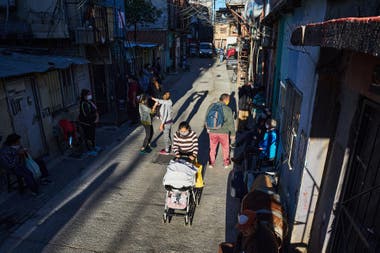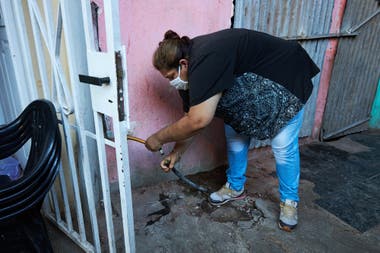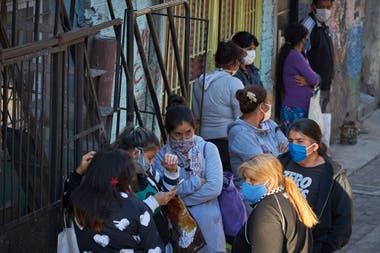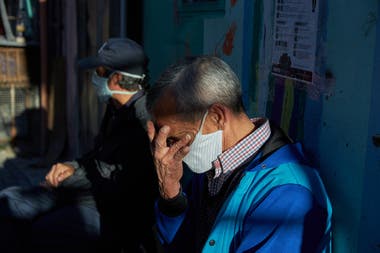How to comply with quarantine when housing is a problem as urgent as the pandemic. That is the challenge of Villa 31 and its neighbors. Walking its streets confirms what specialists have been saying and that many officials are not unaware of: that
isolation
social, so important to fight the coronavirus,
it is not viable
in the most vulnerable neighborhoods. That is why, in them, the popular motto #quedateencasa changed to #quedateenelbarrio, a more realistic but less secure slogan, judging by the curve of infected people inside the villas. In just 24 hours the official number of COVID-19 patients in this settlement quadrupled:
it went from 13 inhabitants to 57.
The lack of space in the houses, in which the
overcrowding
It is a frequent currency, it is combined these days with the
lack of water
and the need to resort to picnic areas and
dining rooms
for the worsening of poverty due to lack of work. The lines to obtain the lunch in the dining room of the Fundación el Pobre de Asís start early, sometimes more than an hour before the start of the deal.
The
distancing
It becomes difficult on this narrow street, where the movement of people and, every now and then, vehicles is constant. From time to time, Carina Corvalán, coordinator of the dining room, leaves the interior of the dining room and asks please those who hope to keep their distance. It also reminds them of the importance of wearing the chinstrap. It is that, where the quarantined shelter is not viable,
the use of chinstrap and physical distance
they become fundamental weapons to slow the advance of COVID-19. However, during the tour that LA NACION made, it could be seen that compliance with both measures is relative. At least during yesterday afternoon, not a few people -especially young people- circulated through the streets of Villa 31 with their faces uncovered and without keeping distance from each other.

”
The need to use dining rooms makes more people on the street
“, recognizes Corvalán, and explains that since the beginning of the quarantine they have had to increase the number of rations due to the increase in demand. Of the 350 daily rations they distributed, today they are close to 500. The dining room distributes snacks and dinner After removing the snack, at 5 in the afternoon, sometimes a little earlier, some women already start the line for the distribution of dinner, scheduled for 18. Also men who, in many cases, live in street situation.
Water, a long-standing problem
Not far from the dining room, within the area known as “Under Highway”, artificial lighting has to be permanent because sunlight does not come. In one of its streets is Ramona, a 43-year-old woman who shares a kitchen and bathroom with her husband, her two children and two nephews. Both she and a niece are diabetic. Also, a daughter and her nephew are disabled. Say what
has been without water since Friday
And he says that no one came to see if he needs anything since the quarantine began.

Ramona is at the door of her house, checking every so often if some water starts to come out of the spout at the entrance. “At some point a little motorcycle came to fill my tank, but after filling it dirty water began to come out. I spoke with a delegate and she explained that they were distributing two types of water, one suitable for drinking and the other for use in the bathroom. they were wrong and
they filled my tank with that dirty water
. How do you want me to take care of cleaning and comply with hand washing if I don’t have water? Every so often the trucks come to deliver, but you have to come with buckets and what you have and stand in line to get water “, this woman is outraged, currently unemployed like her husband, who consumes bottled water, at a rate from 140 pesos the 12 liters.

Four houses of Ramona’s lived the 11 people who, a few days ago, were diagnosed with coronavirus. “Just today the government came to throw water with bleach in the house,” the woman was outraged.
upstairs five tenants live
, that come and go everywhere. They say they called SAME and told them that if they had no symptoms, they should rest easy. But
this morning the family who lives right in front was hospitalized, also due to coronavirus
“The neighbors consulted thought that it was possible that the total number of infected people far exceeded the official figure, although it did not seem that the issue worried them too much.
To optimize what little water there is, the inhabitants of 31 extend their useful life as much as they can. Often the water used for handwashing is later used for dishwashing and finally in the bathroom. María Chaile, from the 100 bis block, is an expert in this type of strategy. He says that in his area
there are apples without water since July
. Yours is one of them. “At night a trickle comes out. So I stay up early at night trying to fill my tank with that trickle. Today I went to bed at 7 in the morning for that matter,” he explains.

On the way to that area is the beach, an open space with a lot of circulation of people, with functioning shops and informal stalls where everything from fruits and vegetables to used goods is sold. A not inconsiderable proportion of passersby walk without a mask, but
controls are not displayed
of any kind during the tour, although the presence of police is seen. “Now it is fulfilled more than before. At first it was very difficult for the chinstrap,” recalls Chaile.
Growing population
In this neighborhood full of contrasts, with better or worse finished houses but always barred, these days there are hardly any children. Few older adults are also seen. To cut the path, every so often we enter corridors with no natural light and poor ventilation.
While official figures estimate that the Barrio Padre Mugica, former villa 31, has around 43,000 inhabitants, Corvalán comments that, according to internal censuses, the figure is around
65,000
people approximately. “At some point it was said that more people could not come, that more could not be built, but it continued to build. This continued to grow,” explains Corvalán, who is also a social worker. Walking through the streets of the neighborhood it is common to come across mixers and construction materials. It can also be seen that the buildings at height continue to be visible to everyone.
Before the pandemic, María was employed by a cleaning company and in family homes. Due to the quarantine, she became unemployed.
9 people live in his house
. “My two daughters, my partner and I live downstairs. We have a room, a kitchen and a bathroom. Other family members live upstairs but they are only two rooms without a bathroom or kitchen, so they share with us,” she explains. “We live on rice and noodles. There is no vegetable. And for meat, very occasionally. Yesterday we bought four eggs at ten pesos each,” he laments.
In block 100, another one that has been without water for months, Silvana lives with her seven children and her son-in-law in a two-story house. Downstairs, they have an environment that serves as a kitchen-dining room, a bathroom and a minimal patio where it conserves water for all family needs. Upstairs they all sleep together. “This is my tank,” says the woman, pointing
a plastic trash can with a lid
, of around 100 liters. “When there is water, I turn on the motor and fill it with the hose. We get out of here for everything we need. But we don’t have it,” he laments, as he shows how little he could collect inside that container.

Returning to the dining area, María and Carina recognize that food assistance exists, although it is lacking. In the
press conference this morning
, the Minister of Human Development and Habitat, María Migliore, said that different actions are being carried out in vulnerable neighborhoods. One of them is food delivery, which is articulated with community leaders. LA NACION tried to communicate with the secretary of Urban Social Integration, Diego Fernández, but so far received no response. “What happens is that, when the government delivers food to the referees so that they distribute, it does not always reach those who need it most. Sometimes it reaches the dining rooms, but very little,” Chaile laments.
It is almost five in the afternoon and there is already a line for dinner in the dining room of Poor Assisi. One of the first is Elsa, who tells that she is coming for the first time. “I used to live under the highway, but now they relocated us. We live much better, in a very nice apartment. There are nine of us in the family, but we cannot work. Before quarantine, I opened taxi doors at the Carrefour de Vélez Sarsfield and My children went out to carton, but now we cannot. I only receive a pension and with that we live. Luckily they told us that for three months we do not have to pay the house because it would have no way, “explains the woman while she waits.


In the queue some women chat and take pictures. There are those who save the place for others, who went to look for their
tuppers
. Carina comes out every once in a while to remind them to keep physical distance while everyone dodges a tanker that passes with water. That of the coronavirus is one of the many fronts against which the city 31 is battling. The State has, in this place, a huge challenge ahead: to ensure that daily emergencies do not lose sight of this invisible enemy, volatile and silent, which has already settled among its inhabitants.
How to collaborate
- The
The Poor of Assisi Foundation
, she receives donations to buy food, chinstraps and gloves, her main needs. Account N °: 020654/5 of Banco Provincia, branch 4003 (CBU: 140003801400302065456).
https // donaronline.org / foundation-the-poor-of-assis / club-of-friends
ALSO
.
Publicado en el diario La Nación




